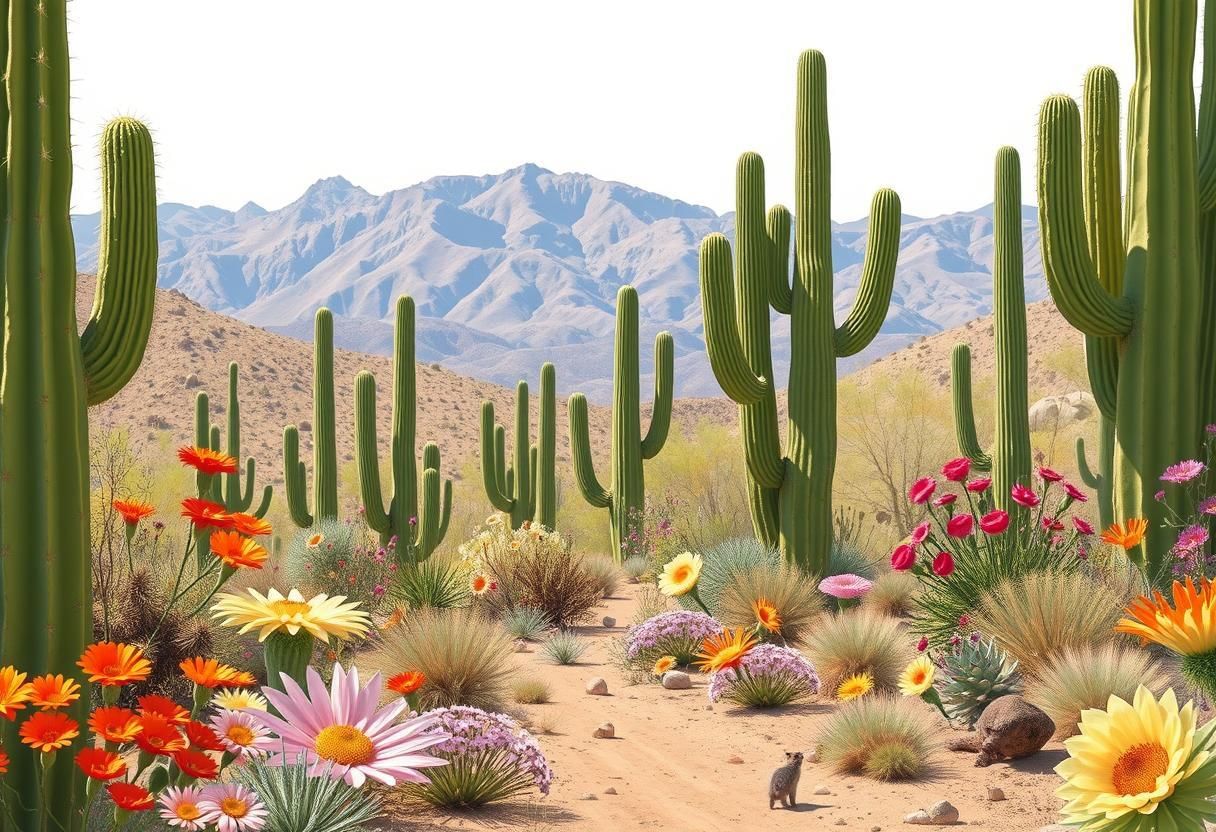Ecosystems Chapter Notes | Biology for BMAT (Section 2) PDF Download
| Table of contents |

|
| The Sonoran Desert |

|
| More About Ecosystems |

|
| Intruders in an Ecosystem |

|
| Project: Impact of an Introduced Species Overview |

|
The Sonoran Desert
 Desert Life
Desert Life
The photograph depicts the Sonoran Desert in Arizona, USA. Deserts present harsh conditions for both animals and plants due to their limited rainfall. Organisms in these regions have evolved specific adaptations to survive with minimal water. The tall plants visible in the image are known as saguaro cacti, which grow at a very slow pace. The cacti shown in this photograph may be over 100 years old. Their roots spread out just beneath the surface of the soil, enabling them to absorb any rainfall that occurs.
Animal Life in the Sonoran Desert
- Gila woodpeckers create nests by drilling holes in the saguaro cacti. Other bird species also utilize these holes for nesting.
- Cactus wrens prefer to nest in a different type of cactus called the teddy bear cholla, which has spiky thorns that protect their eggs and young chicks from predators.
- During hot daytime temperatures, animals such as lizards and tortoises seek refuge in the shade provided by plants or burrow into the cooler soil to escape the heat.
- At night, when temperatures drop, kangaroo rats emerge to forage for food while remaining vigilant for predators like rattlesnakes and coyotes.
Seasonal Changes in the Sonoran Desert
- The Sonoran Desert experiences infrequent but heavy rainfall, particularly during the monsoon season.
- When the rain finally arrives, it transforms the desert landscape.
- Many plants respond to the rainfall by rapidly producing flowers.
- Insects play a crucial role during this time by feeding on the nectar and pollen of the flowers, aiding in pollination and plant reproduction.
- At night, bats also feed on the nectar from agave flowers.
- Seeds that fall to the ground are collected by ants, who store them in their nests as a food source. Some seeds may remain uneaten for months or even years before germinating into new plants.
The Desert Ecosystem
The desert ecosystem is a complex web of interactions between living organisms and the non-living components of the environment. These interactions include food webs, where plants serve as the primary producers, harnessing sunlight to create food. Animals then consume these plants and each other, transferring energy through the food web. In addition to being food sources, plants provide essential services:
- They offer nesting sites for various animals.
- Their roots help stabilise the soil, preventing erosion during heavy rainfall.
This stabilisation is crucial as it prevents soil erosion during rain. Animals contribute to the ecosystem by pollinating plants and dispersing their seeds. The study of these intricate interactions is known as ecology, and researchers continue to uncover new facets of how ecosystems function, even in well-studied areas like the Sonoran Desert.
Non-Living Components of the Desert
The organisms in the Arizona desert interact with the non-living components of their environment in various ways:
- Light: Bright sunlight is crucial for plants to carry out photosynthesis, which produces the food that sustains other organisms in the ecosystem.
- Temperature: The desert experiences extreme temperatures, being hot during the day and significantly cooler at night. Nocturnal animals, such as kangaroo rats, have adapted to this by being active at night, avoiding the heat and potential dehydration.
- Soil: The rocky soil in the desert provides essential minerals needed for plant growth and serves as a habitat for ground-nesting birds.
- Water: Water is vital for all organisms as it is necessary for various cellular processes and reproduction. Rainfall triggers increased activity and reproduction among organisms.
- Air: The air is a source of carbon dioxide for plants during photosynthesis and oxygen for respiration by all living organisms.
Organismal Impact on the Environment
Organisms also play a role in shaping their environment. For instance, the droppings of kangaroo rats enrich the soil with nutrients. Additionally, the gases that these animals inhale and exhale help maintain the balance of atmospheric gases, influencing various ecological processes.
Ecosystem Interactions
All the elements in the desert, both living and non-living, interact with each other, creating a complex and interdependent ecosystem. An ecosystem is essentially a network of interactions among living organisms and their non-living surroundings, working together to sustain life.
Habitats in a Desert Ecosystem
A habitat refers to the natural living environment of an organism. Deserts offer a variety of habitats tailored to the needs of different organisms:
- Saguaro Cactus: This iconic cactus species thrives in the open expanse of the desert, providing essential resources for various organisms.
- Gila Woodpecker: This bird species makes its home inside the protective confines of a saguaro cactus, where it also forages for food both in the air and on the ground.
- Desert Ant: These ants establish their colonies beneath rocks and soil, as well as on the surface of the soil, playing a crucial role in the ecosystem.
- Termites: Termites build their nests at the base of saguaro cactus stems, where they find both food and shelter, contributing to the nutrient cycle.
- Sap Beetles: These beetles inhabit the flowers of saguaro cacti, feeding on the nectar and pollen, and assisting in pollination.
- Kangaroo Rats: These nocturnal rodents dig burrows in the desert soil, emerging at night to scavenge for food, thereby aerating the soil and contributing to nutrient cycling.
More About Ecosystems
The ecosystem of the Arizona Desert is just one example among the diverse range of ecosystems found on our planet. Let's take a closer look at three more types of ecosystems:
1. Mangrove Forest Ecosystem
- Mangroves are unique trees that can grow with their roots submerged in seawater, creating dense forests along the coastlines of many tropical countries.
- Habitat for Young Fish : Young fish find safety and shelter among the tangled roots of mangrove trees, which protect them from larger predatory fish.
- Mud Skippers : These fish venture onto the mudflats when the tide goes out, searching for food in the exposed sediments.
- Decomposition : When mangrove leaves fall into the water, bacteria break them down, and prawns and crabs consume these decomposed leaves, recycling nutrients back into the ecosystem.
- Crab-Eating Macaques : These monkeys climb through the branches of mangrove trees to catch crabs found on the roots and in the mud, contributing to the nutrient cycling in the mangrove ecosystem.
2. Sea Ice Ecosystem in the Arctic Ocean
- Winter Freezing : During the winter months, the extreme cold causes seawater in the Arctic Ocean to freeze, resulting in the formation of sea ice.
- Seals : These marine mammals hunt for fish beneath the ice but need to break through the surface to breathe, relying on the ice as a platform.
- Polar Bears : As apex predators, polar bears roam the sea ice in search of seals to hunt; they are also skilled swimmers, capable of covering large distances in the water.
- Arctic Foxes : These foxes scavenge for food on the sea ice, taking advantage of the resources available in this harsh environment.
- Algae Growth : When there is sufficient light, tiny algae can grow on the underside of the sea ice, providing a food source for small marine organisms.
- Food Chain : Small shrimp-like creatures feed on the algae, and then fish consume these small shrimp, creating a vital link in the Arctic food chain.
3. Rice Paddy Ecosystem in Malaysia
- This rice paddy ecosystem in Malaysia is cultivated and managed by local farmers who play a crucial role in its upkeep.
- Seasonal Flooding : The fields are intentionally flooded at specific times of the year, creating a habitat for algae, which thrive in the shallow water.
- Influx of Fish : Fish from nearby irrigation canals enter the flooded fields, contributing to the biodiversity of the ecosystem.
- Breeding : Frogs and dragonflies utilize the shallow water for breeding, taking advantage of the warm temperatures and abundant food resources.
- Temperature Regulation : The shallow water heats up quickly during the day and cools down rapidly at night, creating a suitable environment for various organisms.
- Use of Fertilisers : Farmers apply fertilisers to enhance the growth of rice and algae, providing more food for animals and increasing overall productivity.
- Bird Habitat : The rice paddy fields attract various bird species that feed on the abundant food sources available in and around the fields.
Intruders in an Ecosystem
New Species in an Ecosystem
Ecosystem studies focus on the interaction between organisms and their environment. This part looks at what happens when a new species suddenly appears in an ecosystem.
Introduced Species in New Zealand
- New Zealand is in the Pacific Ocean, away from other land for about 66 million years. This distance helped unique species grow in New Zealand, different from those in other places.
- Before People Came : New Zealand had no meat-eating mammals. Birds like the kiwi could nest on the ground safely because there were no animal hunters.
- When People Came and Brought New Animals : About 700 years ago, people came to New Zealand and brought animals like rats that harmed native birds by eating their eggs and babies.
- More Animals and Their Effects : Farmers brought sheep for wool and meat, and rabbits for food. Rabbits escaped and ate the same food as sheep, so farmers brought stoats from Europe to kill rabbits.
- Stoats and Other Invaders : Stoats became strong hunters and made some native birds like the laughing owl and New Zealand thrush extinct. They kill nearly 60% of kiwi chicks.
- Trying to Control Stoats : People are trying to control stoats, but getting rid of them completely is hard.
- Birds Going Extinct : Since people came, 53 native bird types in New Zealand are thought to be extinct, mostly because of new animal invaders.
Bioaccumulation DDT
DDT is a chemical used to kill insects. It was first made in the 1940s and used to control insects that spread diseases like malaria and to protect crops. At first, people did not know that DDT could harm animals other than insects.
Later, it became clear that DDT was harmful to other animals. In 1962, Rachel Carson wrote a book called Silent Spring, which talked about the bad effects of DDT and similar chemicals on the environment, especially on birds. Her book made people aware of the dangers of some insecticides.
Persistence and Bioaccumulation
DDT is a chemical that does not break down easily in the environment. It can stay for many years without getting decomposed. When DDT is sprayed, some of it can go into the air and be carried to faraway places. Once it gets into an animal's body, it stays there for the whole life of the animal, causing bioaccumulation, where the chemical builds up in the tissues of the animal. DDT is harmful to many animals and can cause problems, such as making bird eggshells thin and weak. For example, female ibises with DDT in their bodies laid eggs that did not hatch because the shells were weak.
Bioaccumulation and Biomagnification DDT is sprayed onto water, tiny algae absorb some of it. Shrimps eat these algae, leading to DDT accumulation in their bodies. This continues up the food chain, with each organism accumulating DDT over time. The longer an organism lives and the more DDT it consumes, the more DDT builds up in its body. Biomagnification occurs as each organism in the food chain eats others, increasing the concentration of DDT in their bodies. For example, all the DDT from the shrimps a fish eats accumulates in the fish. Similarly, all the DDT from the fish a cormorant eats accumulates in the cormorant.
Example of DDT Concentration in a Food Chain
- DDT is sprayed onto water to kill mosquito larvae. Tiny single-celled protoctists absorb DDT, with a concentration of 0.00005 ppm.
- Protoctists have a concentration of 0.04 ppm.
- Shrimps consume a large quantity of protoctists, raising their DDT concentration to 0.16 ppm.
- Minnows eat shrimps, achieving a concentration of 0.50 ppm.
- Cormorants eat minnows, accumulating a concentration of 26.40 ppm.
Project: Impact of an Introduced Species Overview
This project looks at how people use scientific knowledge to understand and improve things. It focuses on the worldwide effects of science on the environment.
Task
Find out about how a new or invasive species affects an ecosystem. Work in groups of three or four to do the research.
Research Questions
- Native Habitat: Where does the species originally come from?
- Introduction Reasons: Why and when was the species brought to your country?
- Ecosystem Impact: How has the species affected the ecosystems it has been introduced to?
- Invasiveness: Is the species invasive? If so, what makes it invasive in your country but not in its native habitat?
- Initial Oversight: Why didn’t people realise the potential problems when the species was first introduced? How has awareness improved over time?
- Control Measures: Are there efforts to eradicate or control the species? What methods are being used, and how successful are they? Are there differing opinions on this approach?
Presentation
Get ready to share your findings with others in a presentation.
1. The Importance of Initial Assessment for Students with Disabilities
 Context Length Exceeded
Context Length Exceeded
- Conducting an initial assessment for students with disabilities is crucial for identifying their specific needs and challenges.
- This assessment helps in understanding the unique abilities and difficulties faced by each student, which is essential for developing an effective learning plan.
2. Role of Special Educators in Initial Assessment
- Special educators play a vital role in the initial assessment process.
- They possess the expertise to evaluate students' strengths and weaknesses accurately and to recommend appropriate interventions and support strategies.
3. Components of Initial Assessment
- The initial assessment typically includes a range of evaluations such as cognitive tests, behavioural assessments, and observations of the student in different settings.
- It may also involve gathering information from parents, teachers, and other professionals involved with the student.
4. Developing an Individualized Education Plan (IEP)
- Based on the findings of the initial assessment, an Individualized Education Plan (IEP) can be developed.
- The IEP outlines specific goals, accommodations, and support services tailored to the student's needs.
5. Importance of Regular Monitoring and Review
- After the initial assessment and the development of the IEP, it is important to regularly monitor the student's progress and review the plan as needed.
- This ensures that the support provided remains relevant and effective as the student's needs may change over time.
|
1 videos|47 docs|15 tests
|
FAQs on Ecosystems Chapter Notes - Biology for BMAT (Section 2)
| 1. What are some common non-living things found in a desert ecosystem? |  |
| 2. What types of habitats can be found in a desert ecosystem? |  |
| 3. How do desert ecosystems differ from other ecosystems like mangrove forests or rice paddies? |  |
| 4. What role do living organisms play in a desert ecosystem? |  |
| 5. How can new species impact an existing ecosystem? |  |




















